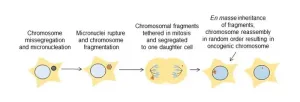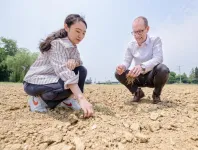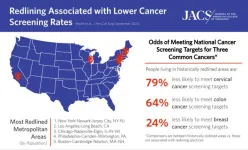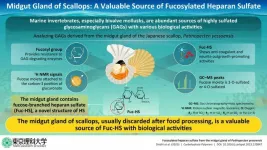(Press-News.org) Washington, DC—As the world heats up due to climate change, how much can we continue to depend on plants and soils to help alleviate some of our self-inflicted damage by removing carbon pollution from the atmosphere?
New work led by Carnegie’s Wu Sun and Anna Michalak tackles this key question by deploying a bold new approach for inferring the temperature sensitivity of ecosystem respiration—which represents one side of the equation balancing carbon dioxide uptake and carbon dioxide output in terrestrial environments. Their findings are published in Nature Ecology & Evolution.
“Right now, plants in the terrestrial biosphere perform a ‘free service’ to us, by taking between a quarter and a third of humanity’s carbon emissions out of the atmosphere,” Michalak explained. “As the world warms, will they be able to keep up this rate of carbon dioxide removal? Answering this is critical for understanding the future of our climate and devising sound climate mitigation and adaptation strategies.”
Photosynthesis, the process by which plants, algae, and some bacteria convert the Sun’s energy into sugars for food, requires the uptake of atmospheric carbon dioxide. This occurs during daylight hours. But through day and night, these same organisms also perform respiration, just like us, “breathing” out carbon dioxide.
Being able to better quantify the balance of these two processes across all the components of land-based ecosystems—from soil microbes to trees and everything in between—and to understand their sensitivity to warming, will improve scientists’ models for climate change scenarios.
In recent years, researchers—including Carnegie’s Joe Berry—have developed groundbreaking approaches for measuring the amount of carbon dioxide taken up by plants through photosynthesis, such as using satellites to monitor global photosynthetic activity and measuring the concentration of the atmospheric trace gas carbonyl sulfide.
But, until now, developing similar tools to track respiration at the scale of entire biomes or continents has not been possible. As a result, respiration is often indirectly estimated as the difference between photosynthesis and the overall uptake of carbon dioxide.
“We set out to develop a new way to infer how respiration is affected by changes in temperature over various ecosystems in North America,” said Sun. “This is absolutely crucial for refining our climate change projections and for informing mitigation strategies.”
Michalak, Sun, and their colleagues developed a new way to infer at large scales how much respiration increases when temperatures warm using measurements of atmospheric carbon dioxide concentrations. These measurements were taken by a network of dozens of monitoring stations across North America.
The team revealed that atmospheric observations suggest lower temperature sensitivities of respiration than represented in most state-of-the-art models. They also found that this sensitivity differs between forests and croplands. Temperature sensitivities of respiration have not been constrained using observational data at this scale until now, as previous work has focused on sensitivities for much smaller plots of land.
“The beauty of our approach is that measurements of atmospheric carbon dioxide concentrations from a few dozen well-placed stations can inform carbon fluxes at the scale of entire biomes over North America,” Sun explained. “This enables a more comprehensive understanding of respiration at the continental scale, which will help us assess how future warming affects the biosphere’s ability to retain carbon,” Sun emphasized.
To their surprise, the researchers found that respiration is less sensitive to warming than previously thought, when viewed at the biome or continental scale. But they caution that this temperature sensitivity is just one piece of a complex puzzle.
“Although our work indicates that North American ecosystems may be more resilient to warming than plot-scale studies had implied, hitting the brakes on climate change ultimately depends on us ceasing to inject more and more carbon into the atmosphere as quickly as possible. We cannot rely on the natural components of the global carbon cycle to do the heavy lifting for us,” Michalak cautioned. “It is up to us to stop the runaway train.”
Other members of the research team include: Xiangzhong Luo, Yao Zhang, and Trevor Keenan of University of California Berkeley and Lawrence Berkeley National Laboratory; Yuanyuan Fang of the Bay Area Air Quality Management District; Yoichi P. Shiga of the Universities Space Research Association; and Joshua Fisher of Chapman University.
__________________
This study was funded by the NASA Terrestrial Ecology Interdisciplinary Science and Carbon Monitoring System, the Carnegie Institution for Science’s endowment, Singapore’s Ministry of Education, the RUBISCO SFA, which is sponsored by the Regional and Global Model Analysis Program in the Climate and Environmental Sciences Division of the Office of Biological and Environmental Research in the U.S. Department of Energy Office of Science, and NASA.
The Carnegie Institution for Science (carnegiescience.edu) is a private, nonprofit organization headquartered in Washington, D.C., with three research divisions on both coasts. Since its founding in 1902, the Carnegie Institution has been a pioneering force in basic scientific research. Carnegie scientists are leaders in the life and environmental sciences, Earth and planetary science, and astronomy and astrophysics.
END
How will a warming world impact the Earth’s ability to offset our carbon emissions?
Plants in the terrestrial biosphere perform a ‘free service’ to us, by taking between a quarter and a third of humanity’s carbon emissions out of the atmosphere. Will they be able to keep this up?
2023-06-15
ELSE PRESS RELEASES FROM THIS DATE:
New research shows the benefits of teaching pupils about mental health in the classroom
2023-06-15
Giving schools the right resources and training to teach pupils about mental health really can have a positive impact on young people’s wellbeing.
New research by Welsh academics has just been published demonstrating the benefits of improving pupils’ mental health literacy and reducing the stigma around mental health issues at a crucial stage in a young person’s life.
Most mental health problems start in the teenage years with a recent survey identifying that two in five young people report mental health symptoms. However, due to poor knowledge ...
Tethering of shattered chromosomal fragments paves way for new cancer therapies
2023-06-15
Healthy cells work hard to maintain the integrity of our DNA, but occasionally, a chromosome can get separated from the others and break apart during cell division. The tiny fragments of DNA then get reassembled in random order in the new cell, sometimes producing cancerous gene mutations.
This chromosomal shattering and rearranging is called “chromothripsis” and occurs in the majority of human cancers, especially cancers of the bones, brain and fatty tissue. Chromothripsis was first ...
Diagnosis of rare, genetic muscle disease improved by new approach
2023-06-15
It’s not easy to distinguish between the dozens of subtypes of limb girdle muscular dystrophy — a rare, genetic muscle disease characterized by weakness in the hips and shoulders that causes difficulty walking and lifting the arms. Until now, determining the subtype has not been critical in caring for patients, because no specific treatments have been available. But gene therapies are on the horizon, and such therapies are targeted to specific genetic variants, so pinpointing the genetic roots of each patient’s disease has taken on a new importance.
In new research, a team at Washington University ...
Analysis of race and ethnicity, socioeconomic factors, and tooth decay among children
2023-06-15
About The Study: In this retrospective cohort study, large proportions of disparities in time to first tooth decay associated with race and ethnicity were explained by insurance type and dental procedure types among children and adolescents. These findings can be applied to develop targeted strategies to reduce oral health disparities.
Authors: Sung Eun Choi, S.M., Ph.D., of the Harvard School of Dental Medicine in Boston, is the corresponding author.
To access the embargoed study: Visit our For The Media website at this link https://media.jamanetwork.com/
(doi:10.1001/jamanetworkopen.2023.18425)
Editor’s ...
Prevalence of diabetic retinopathy in the US
2023-06-15
About The Study: In 2021, it is estimated that 9.6 million people in the U.S. (26% of those with diabetes) had diabetic retinopathy and 1.84 million people (5% of those with diabetes) had vision-threatening diabetic retinopathy. There was marked variation in prevalence across states and the number of people living with diabetes-related eye disease grew substantially since prevalence was last estimated in 2004 and may grow in the coming decades due to the increasing burden of diabetes among youth and adults.
Authors: Elizabeth A. Lundeen, Ph.D., of the Centers for Disease Control and Prevention in Atlanta, is the corresponding author.
To access ...
Use of wearable activity trackers to improve patient physical activity, other outcomes in adults who are hospitalized
2023-06-15
About The Study: In this systematic review and meta-analysis of 15 studies and 1,900 participants, interventions that used wearable activity trackers with patients who are hospitalized were associated with higher physical activity levels, less sedentary behavior, and better physical functioning compared with usual care.
Authors: Carol Maher, Ph.D., of the University of South Australia in Adelaide, South Australia, Australia, is the corresponding author.
To access the embargoed study: ...
Shock to the crop system
2023-06-15
As the world faces more climate variability and extremes in the face of global warming, sudden environmental changes add an extra layer of stress to food production in the United States and around the world. It is critical, then, to figure out how the areas in which crops are planted and harvested respond to these stressors, which can bring on ‘shocks’ in production – or, put differently, sudden and statistically significant crop declines.
These production shocks are a big concern in terms of food stability and many crops in the United States—such as corn, cotton, soybeans, and wheat — are all experiencing more frequent production reductions ...
Researchers demystify the unusual origin of the Geminids meteor shower
2023-06-15
The Geminids meteoroids light up the sky as they race past Earth each winter, producing one of the most intense meteor showers in our night sky.
Mysteries surrounding the origin of this meteoroid stream have long fascinated scientists because, while most meteor showers are created when a comet emits a tail of ice and dust, the Geminids stem from an asteroid — a chunk of rock that normally does not produce a tail. Until recently, the Geminids had only been studied from Earth.
Now, Princeton researchers used observations from NASA’s Parker Solar Probe mission to deduce that it was likely a violent, ...
Historic redlining practices cast a long shadow on cancer screening rates
2023-06-15
Key Takeaways
Banned since 1968, the legacy of redlining persists: There continue to be instances of discrimination affecting people in these historically redlined areas.
Redlining was associated with lower odds of hitting screening targets for all three types of cancer: 24% lower odds in breast cancer, 64% lower odds in colorectal, and 79% lower odds in cervical cancer, compared with non-redlined areas.
Actionable initiatives to improve cancer screening rates: Questionnaires to determine barriers to cancer screening, mobile cancer screening ...
Midgut gland of scallops: a valuable source of fucosylated heparan sulfate
2023-06-15
Glycosaminoglycans (GAGs), including chondroitin sulfate (CS), heparan sulfate (HS), heparin, and hyaluronan are linear and acidic polysaccharides found in the extracellular matrix of all animal tissues. GAGs are widely used as functional ingredients in health products, pharmaceuticals, and cosmetics, and are prepared from biological samples such as shark cartilage and porcine intestinal mucosa. Consequently, the demand for new sources of GAGs is ever-present. For example, the supply source of the anticoagulant heparin—generally prepared from porcine intestinal mucosa in China—was threatened by African swine fever in 2018.
GAGs derived from marine invertebrates—animals ...
LAST 30 PRESS RELEASES:
Heart-brain connection: international study reveals the role of the vagus nerve in keeping the heart young
Researchers identify Rb1 as a predictive biomarker for a new therapeutic strategy in some breast cancers
Survey reveals ethical gaps slowing AI adoption in pediatric surgery
Stimulant ADHD medications work differently than thought
AI overestimates how smart people are, according to HSE economists
HSE researchers create genome-wide map of quadruplexes
Scientists boost cell "powerhouses" to burn more calories
Automatic label checking: The missing step in making reliable medical AI
Low daily alcohol intake linked to 50% heightened mouth cancer risk in India
American Meteorological Society announces Rick Spinrad as 2026 President-Elect
Biomass-based carbon capture spotlighted in newly released global climate webinar recording
Illuminating invisible nano pollutants: advanced bioimaging tracks the full journey of emerging nanoscale contaminants in living systems
How does age affect recovery from spinal cord injury?
Novel AI tool offers prognosis for patients with head and neck cancer
Fathers’ microplastic exposure tied to their children’s metabolic problems
Research validates laboratory model for studying high-grade serous ovarian cancer
SIR 2026 delivers transformative breakthroughs in minimally invasive medicine to improve patient care
Stem Cell Reports most downloaded papers of 2025 highlight the breadth and impact of stem cell research
Oxford-led study estimates NHS spends around 3% of its primary and secondary care budget on the health impacts of heat and cold in England
A researcher’s long quest leads to a smart composite breakthrough
Urban wild bees act as “microbial sensors” of city health.
New study finds where you live affects recovery after a hip fracture
Forecasting the impact of fully automated vehicle adoption on US road traffic injuries
Alcohol-related hospitalizations from 2016 to 2022
Semaglutide and hospitalizations in patients with obesity and established cardiovascular disease
Researchers ‘listen in’ to embryo-mother interactions during implantation using a culture system replicating the womb lining
How changing your diet could help save the world
How to make AI truly scalable and reliable for real-time traffic assignment?
Beyond fragmented markets: A new framework for efficient and stable ride-pooling
Can shape priors make road perception more reliable for autonomous driving?
[Press-News.org] How will a warming world impact the Earth’s ability to offset our carbon emissions?Plants in the terrestrial biosphere perform a ‘free service’ to us, by taking between a quarter and a third of humanity’s carbon emissions out of the atmosphere. Will they be able to keep this up?





